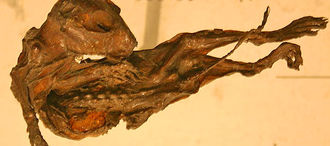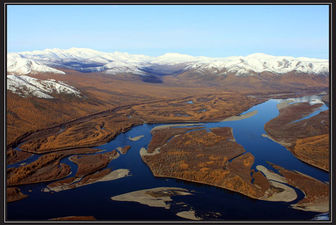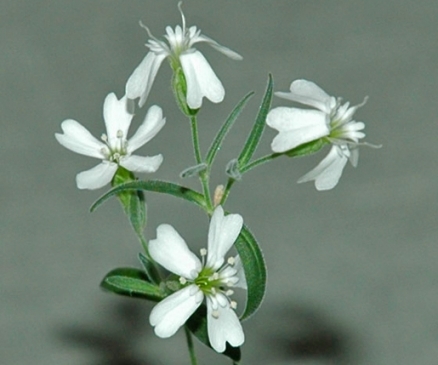Regeneration of Ice Age seeds
Regeneration of Ice Age seeds has become a reality, with dormant seed bank material dating older than 30,000 years before present having been brought to life by Russian scientists. Seeds of the wildflower plant Narrow-leafed campion (Silene stenophylla) were recovered in the Kolyma region of Siberia and induced to produce viable living plants. This flowering forb exhibits a pale lilac flower and attains a stature of approximately seven to 24 centimeters in height.
 Mummified Siberian Arctic ground squirrel from circa 20,000 years before present. Apparently the S.stenophylla seeds were gathered by the Arctic ground squirrel (Spermophilus parryii), a seed gatherer who burrows in the tundra and hibernates over the winter. This ground squirrel characteristically takes seeds to its winter burrow, and descends into the coldest mammalian body temperature realized of approximately minus three degrees Celsius.
Mummified Siberian Arctic ground squirrel from circa 20,000 years before present. Apparently the S.stenophylla seeds were gathered by the Arctic ground squirrel (Spermophilus parryii), a seed gatherer who burrows in the tundra and hibernates over the winter. This ground squirrel characteristically takes seeds to its winter burrow, and descends into the coldest mammalian body temperature realized of approximately minus three degrees Celsius.
Even though the plant species Narrow-leafed campion is still extant, the characteristics of the resurrected plant are somewhat morphologically different from extant individuals, implying some selection has occurred over the last 30,000 years. Although this regeneration has not led to restoration of an extinct taxon, the research clearly evinces a pathway to recontruction of lost organisms.
Contents
Seed bank strategies
It is well known that many plants have reproduction strategies that involve storage and survival of seed material for many years. The seeds may lie dormant for years until appropriate environmental or maturation conditions signal the time to germinate. In some cases the germination signal may be wildfire, and in other cases mechanical scraping or an opportunistic window of meteorlogical conditions. In more unusual conditions the seeds may be preserved over a protracted period of decades or centuries by preservation in unusually arid, special pH or frozen ground conditions.
Geographical setting of the preservation area
 Kolyma River, Siberia. @ Slava Pavlyuk The S.stenophylla seed material was preserved in the Kolyma region of Siberia, in northwestern Russia. This locale is within the Arctic Circle and situated south of the East Siberian Sea and north of the Sea of Okhotsk. The reason for preservation of viable seed material originating in the most recent Ice Age is that the seeds were frozen in permafrost, a soil condition of permanently frozen upper soils. S.stenophylla is endemic to northern Siberia, and is one of the native plants of that region that did not migrate via the Bering Land Bridge during the Pleistocene.
Kolyma River, Siberia. @ Slava Pavlyuk The S.stenophylla seed material was preserved in the Kolyma region of Siberia, in northwestern Russia. This locale is within the Arctic Circle and situated south of the East Siberian Sea and north of the Sea of Okhotsk. The reason for preservation of viable seed material originating in the most recent Ice Age is that the seeds were frozen in permafrost, a soil condition of permanently frozen upper soils. S.stenophylla is endemic to northern Siberia, and is one of the native plants of that region that did not migrate via the Bering Land Bridge during the Pleistocene.
The Arctic ground squirrel who buried the seeds excavated the then tundra to a depth of 20 to 40 centimeters below present day ground surface. The seeds were preserved when the ground froze rather abruptly during the Pleistocene, and remained in permafrost until present time. Fortunately this locale was not subject to glaciation, which process would have scraped the permafrost and destroyed the burrow community. The research team noted of the soils in which the burrows and seeds were found: "The presence of vertical ice wedges demonstrates that it has been continuously frozen and never thawed."
History of Ice Age seed regeneration
Previous seed regeneration had only been conducted for seeds dormant for about two millennia; in particular a cultivar of the date palm (Phoenix dactylifera) was germinated from a 2000 year old stored seed in Israel. In 2007 Russian scientists discovered seed material in certain Siberian squirrel burrows along the Kolyma River banks, which seeds were radiocarbon dated to a time of approximately 31,800 years before present. Initial efforts of direct germination of the seeds were not successful, but subsequent work in laboratories near Moscow involved use of placental material, and yielded germination. In particular, the placental cells were cultured in a sugar medium and complete germination ensued. Apparently these plant tissues were well preserved due to the high natural sugar content of the young cell surroundings.
References
- Michael Black, J. Derek Bewley. 2000. Seed technology and its biological basis. books.google.com 419 pages
- Richard Black. 2012. Ancient plants back to life after 30,000 frozen years. BBC News. Retrieved February 21, 2012.
- Michael Fenner. 2000. Seeds: the ecology of regeneration in plant communities. books.google.com/books ISBN 0851994326 410 pages
- K.M.Helgen, F.R.Cole, L.E.Helgen and D.E.Wilson. 2009. Generic revision in the Holarctic ground squirrel genus Spermophilus. Journal of Mammalogy, 90:270-305.
- V.Stakhov, G.Gyulai, Z.Szabó et al. 2007. Pleistocene-age Silene stenophylla seeds excavated in Russia – a scanning electron microscopic analysis. Botany & Plant Biology July 8, 2007. Chicago, Illinois
